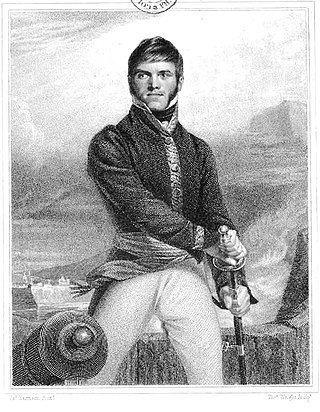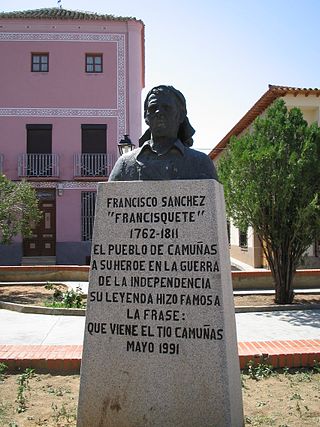
The Peninsular War (1807–1814) was the military conflict fought in the Iberian Peninsula by Portugal, Spain and the United Kingdom against the invading and occupying forces of the First French Empire during the Napoleonic Wars. In Spain, it is considered to overlap with the Spanish War of Independence.

General Martín Francisco Javier Mina y Larrea, nicknamed El Mozo or El Estudiante (Student), was a Spanish lawyer and army officer, who later became a Mexican independence figure.

Juan Martín Díez, nicknamed El Empecinado, was a Spanish military leader and guerrilla fighter, who fought in the Peninsular War.

The 1808 siege of Zaragoza was a bloody struggle in the Peninsular War. A French army under General Lefebvre-Desnouettes and subsequently commanded by General Jean-Antoine Verdier besieged, repeatedly stormed, and was repulsed from the Spanish city of Zaragoza in the summer of 1808.

Valdepeñas is a municipality in the province of Ciudad Real, in the autonomous community of Castile-La Mancha, Spain. It is also the seat of the judicial district that covers the localities of Moral de Calatrava, Santa Cruz de Mudela, Viso del Marqués, Torrenueva, Castellar de Santiago and Almuradiel.
The Battle of Villafranca del Bierzo took place on 17 March 1809, during the French occupation of León in the Peninsular War. After a bloody four-hour siege the small and isolated French garrison at Villafranca surrendered to Spanish regulars under Brigadier José de Mendizábal and General Pedro Caro, 3rd Marquis of la Romana.

The Dos de Mayo or Second of May Uprising took place in Madrid, Spain, on 2–3 May 1808. The rebellion, mainly by civilians, with some isolated military action by junior officers, was against the occupation of the city by French troops, and was violently repressed by the French Imperial forces, with hundreds of public executions.

Juana Galán, nicknamed La Galana, was a Spanish guerrilla fighter of the Peninsular War (1808–1814) who took to the street to fight against the French cavalry that tried to pass through the town of Valdepeñas. At twenty years old, she was considered the best informed woman of the village, because she worked in a strategic location, the first tavern in the village.

Francisco Tomás de Anchia y Urquiza (1783–1831) was a Spanish military commander. Better known as Francisco de Longa, he first saw action during the Peninsular War as a guerrilla leader, eventually becoming incorporated into the regular army, promoted to lieutenant general and being appointed captain general of Old Castile (1825) and captain general of Valencia and Murcia (1827).
The Battle of Arlabán, also known as the First Surprise of Arlabán, took place at the heights of Arlabán, the mountain pass that separates the Basque provinces of Guipúzcoa and Álava, on 25 May 1811, during the Peninsular War.
The following tables show the sequence of events of the Peninsular War (1807–1814), including major battles, smaller actions, uprisings, sieges and other related events that took place during that period.
The Battle of Alcolea Bridge was a minor battle that took place on 7 June 1808, during the Peninsular War, at Alcolea, a small village 10 km from Córdoba, the city that would be invaded by French troops later that same afternoon.

The battle of Valdepeñas was a popular uprising that took place on 6 June 1808, at the beginning of the Spanish War of Independence, in the town of Valdepeñas, Ciudad Real, Castile-La Mancha. Valdepeñas is on the main road from Madrid to Andalusia.
The Uprising of Santa Cruz de Mudela was a popular uprising that took place on 5 June 1808, at the beginning of the Spanish War of Independence, in the town of Santa Cruz de Mudela, Ciudad Real, Castile-La Mancha. Santa Cruz de Mudela is on the main road from Madrid to Andalusia.

Dominique Honoré Antoine Vedel was a French general who participated in the French Revolution, the War of the Fourth Coalition and the Peninsular War.

The Spanish Army of the Peninsular War refers to the Spanish military units that fought against France's Grande Armée during a period which coincided with what is also termed the Spanish War of Independence.

Guerrilla warfare in the Peninsular War refers to the armed civilian actions carried out by non-regular troops against Napoleon's Grande Armée in Spain and Portugal during the Peninsular War.
Events from the year 1808 in Spain.

Francisco Sánchez Fernández, commonly known as Tío Camuñas or Francisquete, was one of the most famous guerrilla fighters of La Mancha during the Peninsula War.
Ramón Gayán y Díaz (1772–1846) was a Spanish military commander.













